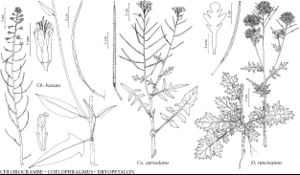Chlorocrambe hastata
Bull. Torrey Bot. Club 34: 436. 1907.
Stems 5–15 dm, (stout). Cauline leaves: petiole 6–15 cm (shorter distally); blade deltate to lanceolate, lyrate, or sinuately lobed, or (distally) narrowly lanceolate, 5–20 cm × 30–70 mm (smaller distally), margins entire or subapically denticulate, apex acute. Fruiting pedicels 5–12 mm, (thicker than gynophore). Flowers: sepals yellowish green, 4–6 × 1–1.5 mm; petals white, 5–7 mm, blade 2.5–4 × 0.5–1 mm, claw 2–3.5 × 1–1.7 mm, margins dentate or incised (sublaciniate); filaments 5–9 mm; anthers 2.5–3.5 mm; gynophore (1–)2–8(–10) mm. Fruits divaricate, 4–13 cm × 1.5–2.5 mm; style obsolete or, rarely, to 0.5 mm. Seeds brown, 3–5 × 1.7–2.2 mm; wing to 0.7 mm wide.
Phenology: Flowering Jun–Aug.
Habitat: Mountain slopes, canyons, alder thickets, shady damp areas, stony and brushy hillsides
Elevation: 1500-2800 m
Distribution

Idaho, Oreg., Utah.
Discussion
Chlorocrambe hastata is rare and known from only a few counties in Idaho (Washington County), Oregon (Baker and Wallowa counties), and Utah (Cache, Salt Lake, Utah, and Wasatch counties). It is easily distinguished from the other North American species of Brassicaceae by having yellowish green, reflexed flowers in lax racemes, hastate and petiolate cauline leaves, and fruits borne on distinct gynophores.
Selected References
None.
